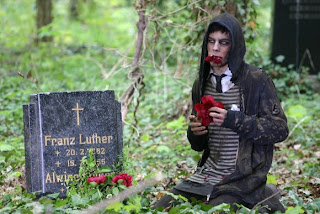 ÉTOLIE VIOLETTE
ÉTOLIE VIOLETTE, Axelle Ropert, 2005
MODS, Serge Bozon, 2002
It was a pity to see that the skinny legged, black coated hipsters who flocked to this screening seemed so disappointed by it – they shuffled out of the cinema and said as much as they teetered down Collins street – because these films were both ingenious and beautiful. They certainly lived up to the MIFF descriptions as “almost impossible to categorize”.
The double screening began with Étoile Violette, a visual exploration of solitude. A group of adults taking a nightclass on literature, entitled ‘The solitude of Jean-Jacques Rousseau’, find that the themes of the class, as well as their lives, is solitude. It is an isolation often expressed through bodily gestures, especially in the disjointed role-play performances that structure the class, which seem to depict compartmentalized psychic lives. The students stand apart, they obscure their faces, the lead Alexandre (played by writer-director Axelle Ropert) loses himself in the repetitive stitching of suits in his work as a tailor.

Similar gestures of isolation, in a more poignant manner, are founded in the musical vignettes that punctuate the text. They are set apart not only by sound, but by a tracking camera that defies the typical notion of character as centre by its mobility. Dwarfing them within unfolding spaces this camera unfurls from the centre of the protagonist towards the textures of the street, the adorned walls of a room, the infinite limbs of trees or the night sky. It was interesting insomuch as these sequences proved to be a more objective slip into reality, into the tangible world of objects (no matter that the style was artistically fantastical), than was offered by the characters. Alexandre in particular privileged a counterpoint that saw him ultimately slip into the psychic world of Rousseau - as was elaborated with a number of fantasy sequences between the two in a forest and a particularly experimental final sequence.

Largely, this film was engaging because the performances were and the interpretation of Rousseau that flows through the narrative was very amusing and reflexive.
MODS, which followed, was an ideal partner piece. An experimental play on rhythm and repetition, held together by a script that was similarly intelligent and witty, it was mainly about bodies and minds in momentum. The characters were unexpected and gave their personalities through performative gestures rather than narrative exploration. These gestures often shifted into mechanized choreographed dance sequences of both symmetry and variety, which were the most fascinating part of the film (and surely a nod to the New Wave, especially Bande a part). The impression was often ritualistic and presented a film text that would be readily available for Structuralist interpretation.

While there was a plot, it developed by continual visual repetition and pattern. It was unified in the final sequences in a charmingly simplistic manner, (again) a script by Ropert enfolding it into a temporal play of Chinese-whispers over a misunderstanding between a boy and a girl. What dialogue there was lyrical, again relying on repetition and the pattern of sounds, but it was rendered with the same thoughtfulness that made Étoile Violette so interesting.

While I found both of these films to be incredibly interesting (and unpretentious) jaunts, redeemed all the more by solid scripts, they will not be many peoples cup of tea. As always, for some, experimental is a warning word for wank, so if more classical story telling is in order look elsewhere. It would be interesting to see what comes next for Bozon, Ropert and their acting team as there was a great continuity between these pieces, especially to observe whether this focus on gesture remains a key storytelling device.
The images on this post were drawn from ALLOCINE, which is an excellent resource for French and European cinema, similar to the irrepresable IMDB.














